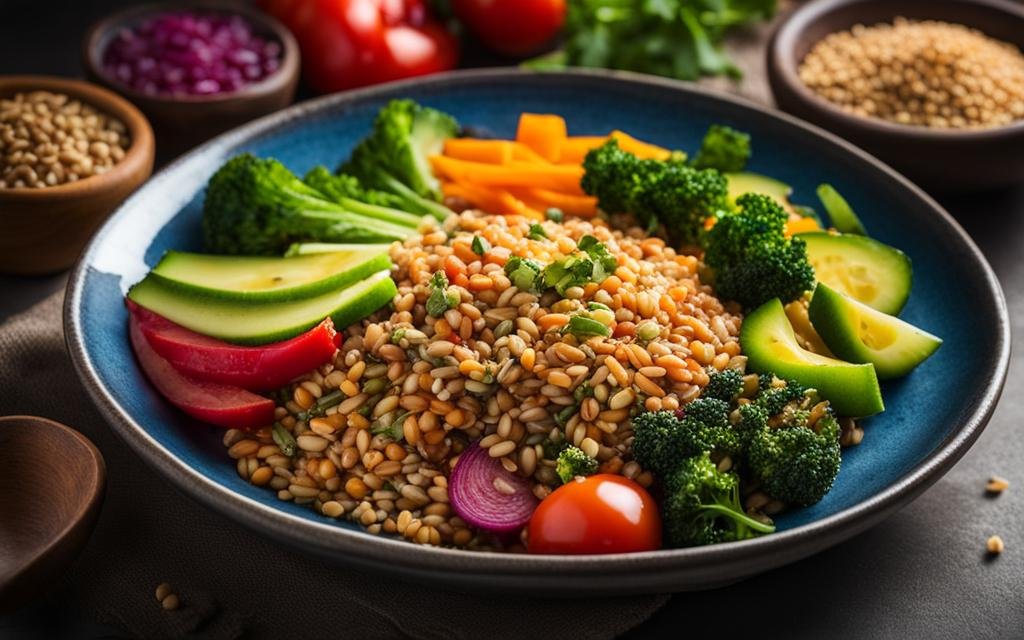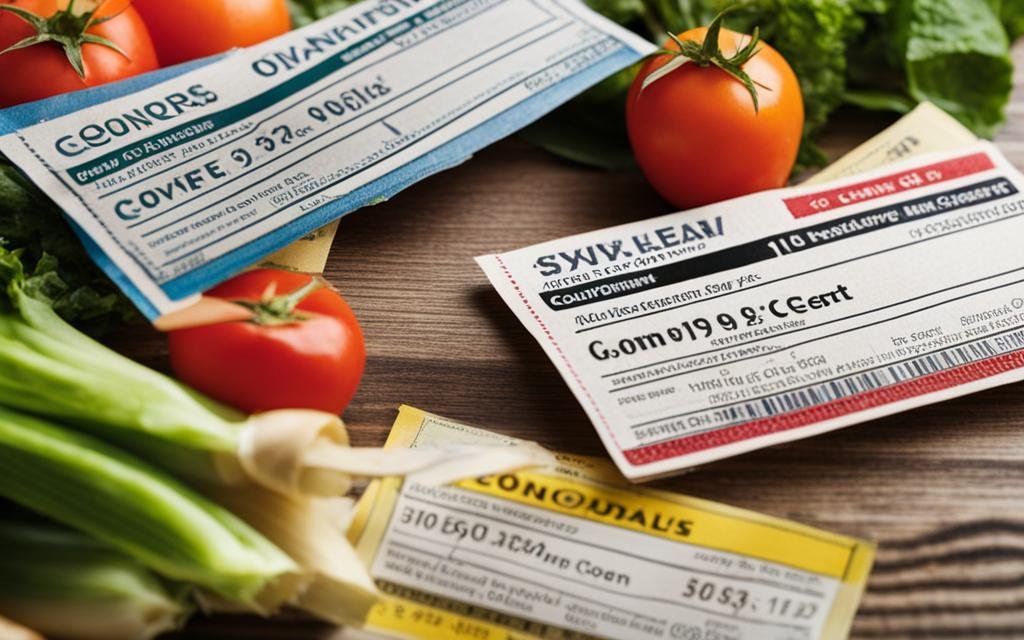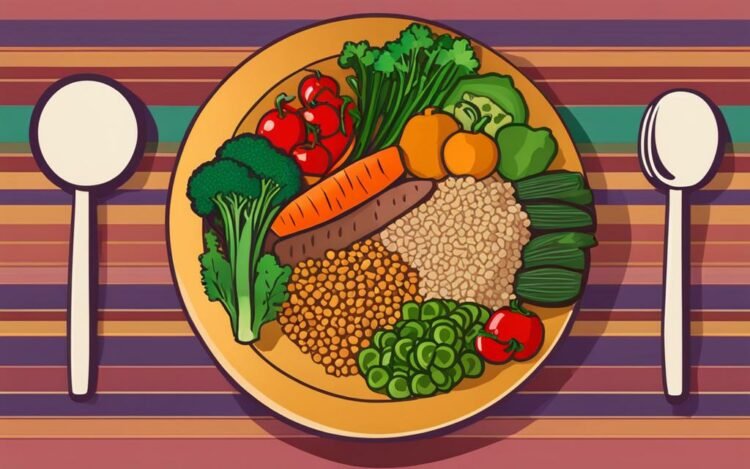Are you looking for ways to enjoy nourishing meals without breaking the bank? Eating healthy on a budget is possible with the right strategies and a little creativity. By making smart choices and following these tips, you can create delicious and nutritious meals that won’t strain your wallet.
When money is tight, it can be tempting to opt for cheaper, unhealthy food options. However, compromising on your health is not the solution. With a little planning and consideration, you can make meals that are both healthy and cost-effective. Here are some practical tips to help you get started:
Key Takeaways:
- Plan your meals and adapt recipes to fit your specific dietary needs.
- Use common ingredients and different herbs and spices to create variety in your meals.
- Make meals that can be frozen or stretched over multiple servings to save time and money.
- Create a shopping list based on your meal plan to avoid impulse buys.
- Buy in bulk for items like nuts and beans to save money.
Plan Your Recipes
When it comes to eating healthy on a budget, meal planning is key. By taking the time to plan your recipes, you can ensure that you’re making nutritious meals that meet your specific dietary needs. Whether you’re following a diabetes diet, looking for low-carb recipes, or trying to incorporate more vegetable substitutes into your meals, proper planning can make a big difference.
One great way to stretch your budget is by finding recipes that use common ingredients. This allows you to buy in bulk and reduce the overall cost of your meals. Additionally, using different herbs and spices can add variety to your dishes without breaking the bank. By exploring flavors and experimenting with seasonings, you can create delicious meals that don’t rely on expensive ingredients.
Another strategy for cost-effective meal planning is to make meals that can be frozen or stretched over multiple servings. Freezing meals not only helps to reduce waste but also saves you time and effort in the kitchen. By preparing extra portions and freezing them, you’ll have ready-made meals for those busy days when cooking from scratch is not an option.
An excellent way to get the most out of your ingredients is by stretching a recipe. For instance, if you’re making a chicken stir-fry, consider adding more vegetables or using less meat to make it go further. This not only helps to reduce the overall cost of the dish but also adds more nutrients to your meal.
When it comes to budget-friendly and nutritious options, healthy soup recipes are a standout choice. Soups are versatile, allowing you to incorporate a variety of vegetables, legumes, and whole grains. They can be made in large batches and easily frozen for future meals. Plus, soups are a great way to use up any leftover ingredients you have on hand.
By taking the time to plan your recipes, you can enjoy healthy and budget-friendly meals that meet your dietary needs. Whether it’s finding low-carb recipes, incorporating vegetable substitutes, or stretching a recipe to make it go further, meal planning is an essential tool in your healthy eating arsenal.

Shop With a List
When it comes to grocery shopping, having a well-planned shopping list can be a game-changer. Not only does it help you stay organized, but it also ensures that you only buy what you need, reducing the chances of impulse buys and wastage. Whether you’re meal planning for the week or just picking up a few essentials, a shopping list can save you time and money.
One of the key benefits of creating a shopping list is that it eliminates the need for unnecessary trips to the grocery store. By knowing exactly what you need, you can make sure to get everything in one go, avoiding any extra trips that might tempt you to buy items you don’t really need.
Buying in bulk is another great way to save money on your grocery bill. For pantry staples like nuts and beans, consider purchasing larger quantities. Not only are bulk items often cheaper per unit, but they also reduce packaging waste. Just make sure to store them properly to maintain freshness.
When it comes to fruits and vegetables, using frozen or canned options can be a convenient and cost-effective choice. They are often more affordable than fresh produce and have a longer shelf life. However, be mindful of choosing options that are low in added sugars or salt to maintain a healthy diet.
Another money-saving strategy is to make use of coupons. Look for coupons in your local newspapers, magazines, or online. They can offer significant discounts on various grocery items, helping you stretch your budget even further. Just remember to check the expiry dates and any terms and conditions before using them.
Now that you know the benefits of shopping with a list, start planning your meals and creating a comprehensive shopping list. Stick to your budget and make savvy choices, such as buying in bulk, opting for frozen or canned produce, and utilizing coupons. These small changes can add up to big savings on your grocery bill without compromising on the quality of your meals.

Cut Cost With Coupons
Using coupons can significantly reduce your grocery bill. By taking advantage of grocery coupons, you can save money on the ingredients you need to prepare healthy meals. Whether you prefer paper coupons or digital coupons, incorporating coupon savings into your shopping routine is a smart way to stay within your budget and still enjoy nutritious meals.
Don’t underestimate the savings potential of even small cents-off coupons. Over time, these seemingly insignificant savings can accumulate into significant amounts. It’s worth the effort of clipping coupons or searching for online coupon codes to maximize your savings and stretch your budget.

When it comes to finding coupons, be sure to explore both paper and digital options. Many grocery stores offer paper coupons in their weekly flyers or through direct mailings. You can also find printable coupons online from various coupon websites or directly from the manufacturers’ websites. Additionally, take advantage of mobile coupon apps, which allow you to digitally redeem coupons at the checkout counter.
To make the most of your coupon savings, match the coupons with sale items or discounted products. Planning your meals around the ingredients you have coupons for will help you maximize your savings. Look for coupons for basic pantry staples, fresh produce, meat, dairy products, and other essentials.
By incorporating coupon savings into your grocery shopping routine, you can enjoy healthy meals while keeping your expenses in check. So don’t forget to check for coupons before heading to the store or making an online purchase. With a little bit of effort in finding and using coupons, you can make frugal shopping a part of your lifestyle and enjoy the benefits of cost-effective grocery shopping.
Buy Store Brands
When shopping on a budget, opting for store brands or generic brands can be a smart choice. These brands are typically more affordable than national brands, but they often offer the same quality and similar ingredients. By purchasing store brand items, you can save a significant amount of money on your food bill without compromising on the taste or nutritional value of your meals.
When it comes to selecting which store brands to buy, consider opting for items like canned tomatoes, milk, olive oil, and frozen fruits and vegetables. These are commonly used ingredients that can be found in store brand versions at a lower price point. In fact, choosing store brands for these items can help you save 20% to 30% compared to purchasing their national brand counterparts.
However, it’s important to compare the ingredients list and nutrition facts panel before making a purchase. This will ensure that you are getting a store brand product without any added ingredients or unnecessary additives. By doing this simple comparison, you can make informed decisions and choose store brands that align with your dietary preferences and health goals.
By embracing store brands, you can enjoy affordable options while still maintaining a nutritious and satisfying diet. So, the next time you’re shopping, consider reaching for those store brand items and see how much you can save without sacrificing quality or flavor.
Conclusion
Eating healthy and nutritious meals while saving money is within reach. By incorporating practical tips and strategies into your routine, you can achieve a balanced diet on a budget. Planning your recipes allows for customization based on your dietary needs and helps in stretching meals over multiple servings. Creating a shopping list ensures you stay focused and avoid unnecessary expenses.
Utilizing coupons can significantly reduce your grocery bill, making healthy eating more affordable. Consider buying store brands, which offer similar quality and ingredients compared to more expensive national brands. By being mindful of your choices and shopping wisely, you can make cost-effective decisions without sacrificing nutrition.
Remember, with a little effort and creativity, you can enjoy a variety of nutritious meals while sticking to your budget. Whether it’s meal planning, utilizing coupons, or choosing store brands, these strategies can make a significant difference. Keep these practical tips in mind and embark on a journey towards healthy eating on a budget.
FAQ
How can I plan my recipes to eat healthy on a budget?
Planning your recipes is essential for eating healthy on a budget. You can adapt recipes to fit your specific dietary needs, such as a low-carb diet for diabetes management. Using common ingredients and different herbs and spices can create variety in your meals without increasing the cost. Additionally, making meals that can be frozen or stretched over multiple servings can help save time and money.
How can I shop with a list to save money on groceries?
Creating a shopping list based on your meal plan can help you avoid impulse buys and unnecessary trips to the grocery store. Buying in bulk can save money, especially for items like nuts and beans. Using frozen or canned fruits and vegetables can be a healthier and more affordable option, as long as you choose options without added sugar or salt. Coupons are also a great way to reduce your grocery bill.
How can I cut costs with coupons?
Using coupons can significantly reduce your grocery bill. Look for both paper and digital coupons to take advantage of savings on the ingredients you need. Even small cents-off coupons can add up to significant savings over time. By making coupon savings a regular part of your shopping routine, you can stay within your budget while still enjoying healthy meals.
Are store brands a good option for saving money on groceries?
Store brands or generic brands are usually cheaper than national brands but offer the same quality and similar ingredients. Buying store brands for items like canned tomatoes, milk, olive oil, and frozen fruits and vegetables can help you save 20% to 30% on your food bill. Before making a purchase, compare the ingredients list and nutrition facts panel to ensure you’re getting a product without added ingredients.
Is it possible to eat healthy on a budget?
Yes, eating healthy and cost-effective meals is achievable with the right strategies. By planning your recipes, shopping with a list, utilizing coupons, buying store brands, and incorporating other money-saving tips, you can nourish your body without breaking the bank. With a little effort and creativity, you can enjoy nutritious meals while sticking to your budget.

